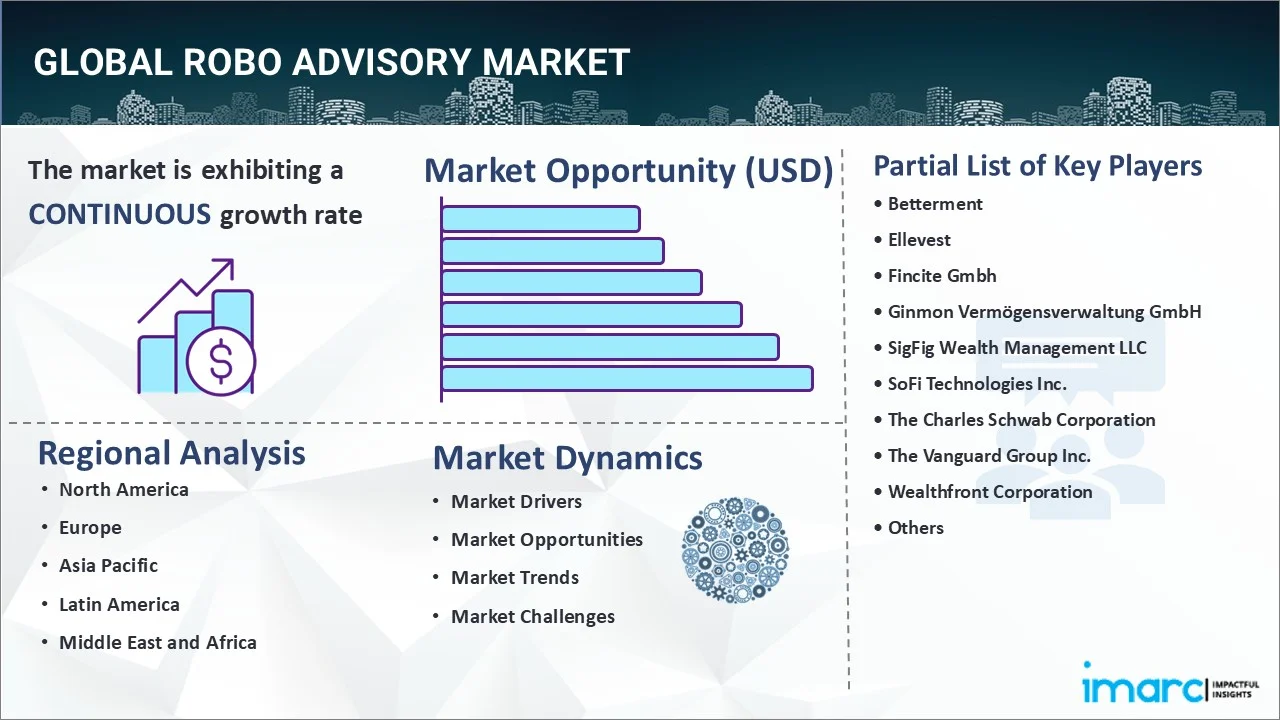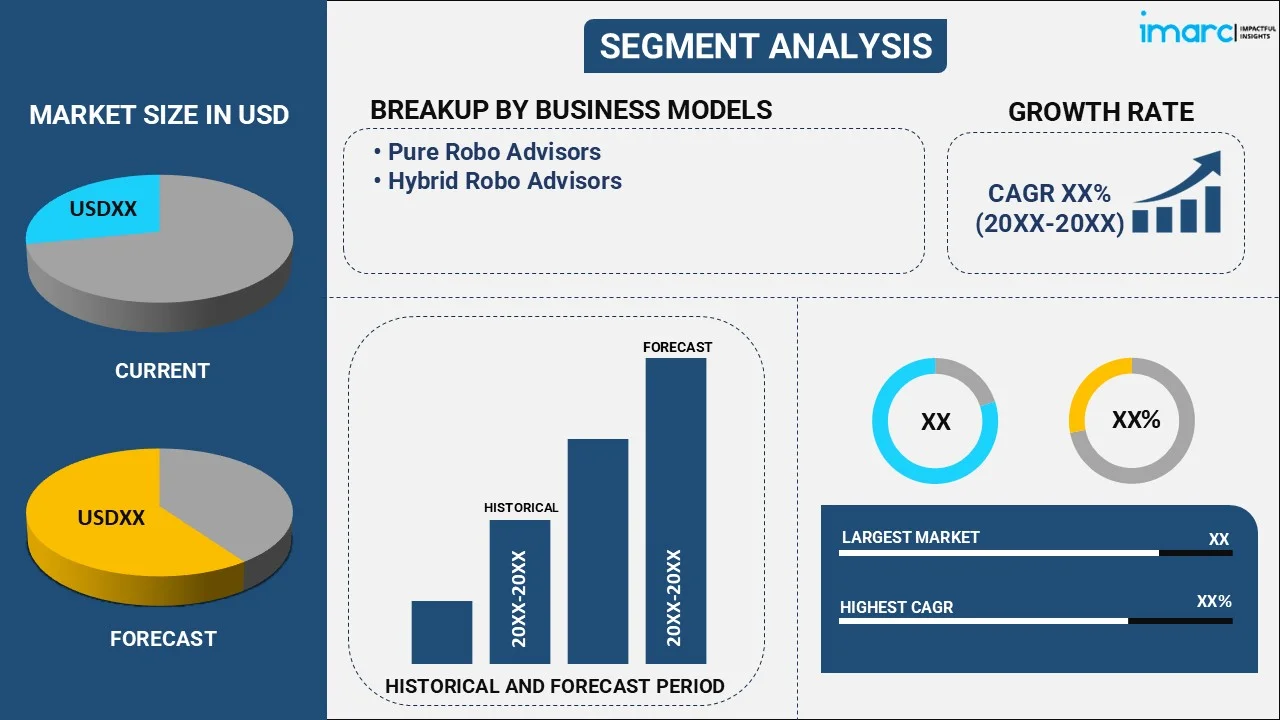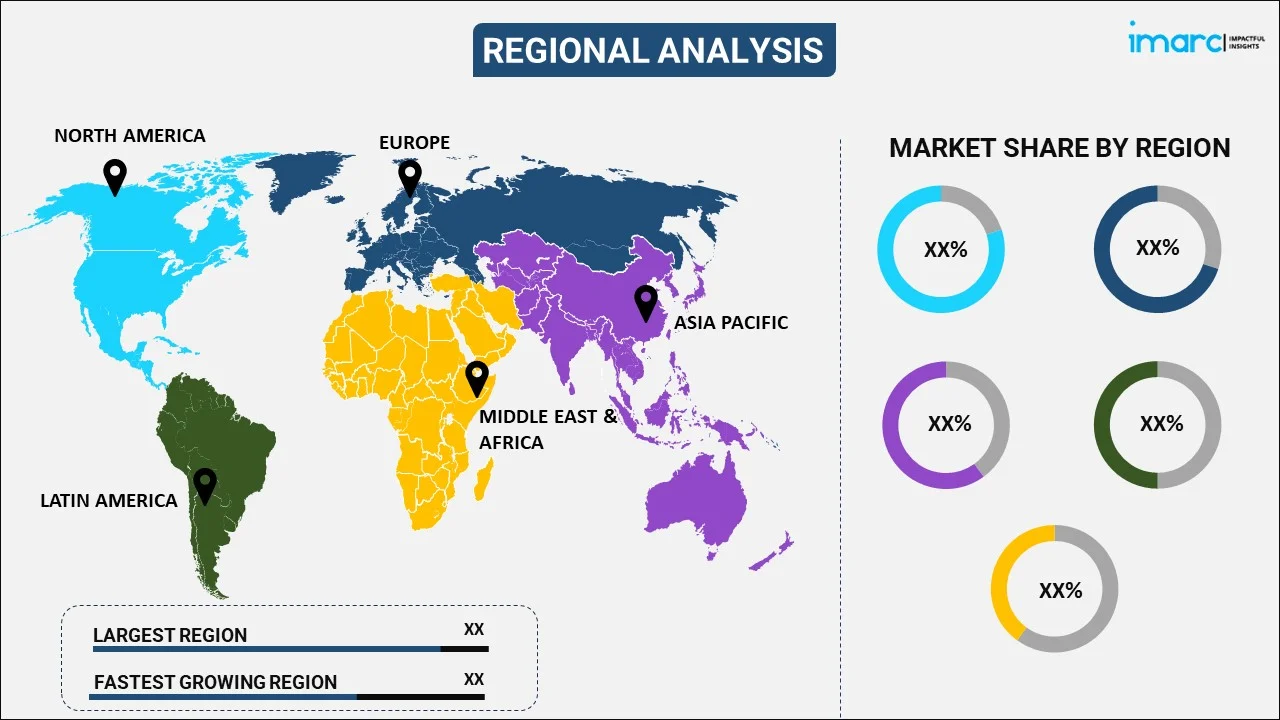
Robo Advisory Market Report by Business Model (Pure Robo Advisors, Hybrid Robo Advisors), Service Type (Direct Plan-Based/Goal-Based, Comprehensive Wealth Advisory), Provider (Fintech Robo Advisors, Banks, Traditional Wealth Managers, and Others), End User (Retail Investor, High Net Worth Individuals (HNIs)), and Region 2025-2033
Global Robo Advisory Market:
The global robo advisory market size reached USD 11.8 Billion in 2024. Looking forward, IMARC Group expects the market to reach USD 92.2 Billion by 2033, exhibiting a growth rate (CAGR) of 24.33% during 2025-2033. Increased demand for accessible financial solutions, ongoing technological advancements, digital transformation, and expansion of financial literacy are primarily driving the market's growth.
|
Report Attribute
|
Key Statistics
|
|---|---|
|
Base Year
|
2024
|
|
Forecast Years
|
2025-2033
|
|
Historical Years
|
2019-2024
|
|
Market Size in 2024
|
USD 11.8 Billion |
|
Market Forecast in 2033
|
USD 92.2 Billion |
| Market Growth Rate 2025-2033 | 24.33% |
Robo Advisory Market Analysis:
- Major Market Drivers: The widespread need for performing algorithmic calculations to analyze data and deliver comprehensive information is driving the robo advisory market growth.
- Key Market Trends: The increasing need for automating complex event processing has led to significant technological advancements, such as the large-scale integration of artificial intelligence (AI) and machine learning (ML) solutions, which are aiding in minimizing the errors caused by human interventions. This is further contributing to the robo advisory market share.
- Competitive Landscape: Some of the prominent market companies include Betterment, Ellevest, Fincite Gmbh, Ginmon Vermögensverwaltung GmbH, SigFig Wealth Management LLC, SoFi Technologies Inc., The Charles Schwab Corporation, The Vanguard Group Inc., Wealthfront Corporation, and Wealthify Limited (Aviva plc), among many others.
- Geographical Trends: North America dominates the overall market. The growth in smartphone and internet usage in the region has been pivotal in driving the adoption of robo-advisory services. The ease of access through mobile applications makes it convenient for investors to monitor and manage their investments in real time, increasing the attractiveness of digital wealth management solutions.
- Challenges and Opportunities: Lack of personalized human interaction and high competition among various players in the market are hampering the robo advisory market share. However, the growing number of digitally native and tech-savvy millennials and Gen Z consumers offers significant growth potential for robo-advisors. These generations prefer digital-first solutions, are cost-sensitive, and value convenience, making them an ideal target market.

Robo Advisory Market Trends:
Rising Number of Smartphones Users
The increasing number of smartphone users is one of the key factors driving the market's growth. For instance, according to Statista, between 2024 and 2029, the global number of smartphone users is expected to increase by 1.7 billion (+37.98%). After the sixteenth consecutive year of growth, the smartphone user base is expected to reach about 6.2 billion users, marking a new high in 2029. With more people owning smartphones, there's an increasing expectation for on-the-go financial services. Robo-advisory apps provide users with 24/7 access to their investment portfolios, enabling them to track, manage, and adjust investments in real time. These factors are expected to propel the robo advisory market share in the coming years.
Growing Digital Transformation Industry
The growing digital transformation industry is driving the market's growth. For instance, according to IMARC, the global digital transformation market size reached US $692 Billion in 2023. Looking forward, IMARC Group expects the market to reach US $2,845 Billion by 2032, exhibiting a growth rate (CAGR) of 16.9% during 2024-2032. Digital transformation has enabled robo-advisors to integrate AI and machine learning algorithms, which are key in delivering personalized investment advice, portfolio optimization, and risk management. These factors further positively influence the robo advisory market size.
Technological Innovations
The growth of artificial intelligence, machine learning, and big data analytics has significantly enhanced the capabilities of robo-advisors. They now offer highly personalized investment strategies, automated rebalancing, and tax optimization, making them a compelling choice for tech-savvy investors. For instance, in February 2024, Revolut launched the robo-advisor service in the EEA to automate investing based on consumer demands. Revolut's Robo-Advisor assigns a portfolio based on users' particular circumstances, such as risk tolerance and financial goals; the assigned portfolio will rebalance automatically as the market moves, thereby boosting the robo advisory market growth.
Global Robo Advisory Industry Segmentation:
IMARC Group provides an analysis of the key trends in each segment of the market, along with forecasts at the global, regional, and country levels from 2025-2033. Our report has categorized the market based on business model, service type, provider, and end user.
Breakup by Business Model:

- Pure Robo Advisors
- Hybrid Robo Advisors
Hybrid robo advisors exhibit a clear dominance in the market
The report has provided a detailed breakup and analysis of the market based on the business model. This includes pure robo advisors and hybrid robo advisors. According to the report, hybrid robo advisors represented the largest market segmentation.
According to the market outlook, many investors, especially those with higher net worth or more complex financial needs, prefer having a human advisor to guide them. The hybrid model addresses this by combining automated investment strategies with human advisory services. It meets the desire for personalized attention while benefiting from low-cost automated management. Moreover, as financial markets become more complex and investors’ needs more diversified, there is a rising demand for sophisticated, customized financial planning. Hybrid models offer a blend of algorithm-driven advice and human insight, which helps investors navigate these complexities more effectively.
Breakup by Service Type:
- Direct Plan-Based/Goal-Based
- Comprehensive Wealth Advisory
Comprehensive wealth advisory holds the majority of the global market share
The report has provided a detailed breakup and analysis of the robo advisory market based on the service type. This includes direct plan-based/goal-based and comprehensive wealth advisory. According to the report, comprehensive wealth advisory represented the largest market segmentation.
According to the robo advisory market overview, as individuals accumulate wealth, their financial situations become more complex. Factors like diversified income streams, business ownership, family trusts, international assets, and multi-generational planning require a comprehensive approach. This complexity drives the need for holistic advisory services that cover all aspects of wealth management. Moreover, investors are increasingly concerned about long-term goals such as retirement, healthcare, and legacy planning. Comprehensive wealth advisory services provide integrated solutions that align with these long-term goals, including risk management, tax optimization, and diversified investments.
Breakup by Provider:
- Fintech Robo Advisors
- Banks
- Traditional Wealth Managers
- Others
Fintech robo advisors represent the largest market share
The report has provided a detailed breakup and analysis of the market based on the provider. This includes fintech robo advisors, banks, traditional wealth managers, and others. According to the report, fintech robo advisors represented the largest market segmentation.
One of the primary demand drivers for fintech robo-advisors is their ability to offer low-cost investment solutions. Compared to traditional wealth management services, robo-advisors provide access to professionally managed portfolios at a fraction of the cost. This affordability appeals particularly to younger investors and those just starting their investment journeys. Moreover, millennials and Gen Z are tech-savvy generations with a strong preference for digital solutions. They value convenience, transparency, and low costs, all of which are core features of fintech robo-advisors. As these younger demographics increase their investment activity, the demand for robo-advisory services is expected to rise further.
Breakup by End User:
- Retail Investor
- High Net Worth Individuals (HNIs)
High net worth individuals (HNIs) account for the majority of the global market share
The report has provided a detailed breakup and analysis of the market based on the end user. This includes retail investor and high net worth individuals (HNIs). According to the report, high net worth individuals (HNIs) represented the largest market segmentation.
HNIs are attracted to the cost-efficiency of robo-advisors, especially when managing large portfolios. Traditional wealth management services often come with high fees, but robo-advisors typically charge lower fees while providing transparent pricing models. This cost advantage is appealing to HNIs who seek to optimize expenses and improve net returns. Moreover, robo-advisors are increasingly incorporating advanced portfolio strategies and diversified investment options, including exposure to alternative assets like real estate, private equity, and hedge funds. This expansion of investment choices appeals to HNIs who are looking for sophisticated investment strategies that align with their risk appetite and financial goals.
Breakup by Region:

- North America
- United States
- Canada
- Asia-Pacific
- China
- Japan
- India
- South Korea
- Australia
- Indonesia
- Others
- Europe
- Germany
- France
- United Kingdom
- Italy
- Spain
- Russia
- Others
- Latin America
- Brazil
- Mexico
- Others
- Middle East and Africa
North America currently dominates the global market
The report has also provided a comprehensive analysis of all the major regional markets, which include North America (the United States and Canada); Asia Pacific (China, Japan, India, South Korea, Australia, Indonesia, and others); Europe (Germany, France, the United Kingdom, Italy, Spain, Russia and others); Latin America (Brazil, Mexico, and others); and the Middle East and Africa. According to the report, North America currently dominates the global market.
According to the market statistics, North America, particularly the U.S. and Canada, has a high rate of digital adoption and technological infrastructure. With advancements in AI, machine learning, and big data analytics, robo-advisors have become more efficient, providing personalized and automated investment solutions. This technological ecosystem has accelerated the adoption of digital financial services in the region. Moreover, the growing familiarity with and trust in digital financial services have contributed significantly to the growth of robo-advisors in North America. As consumers become more comfortable with online banking, digital payments, and fintech solutions, they are increasingly open to using automated investment platforms for managing their wealth.
Competitive Landscape:
The market research report has provided a comprehensive analysis of the competitive landscape. Detailed profiles of all major market companies have also been provided. Some of the key players in the market include:
- Betterment
- Ellevest
- Fincite Gmbh
- Ginmon Vermögensverwaltung GmbH
- SigFig Wealth Management LLC
- SoFi Technologies Inc.
- The Charles Schwab Corporation
- The Vanguard Group Inc.
- Wealthfront Corporation
- Wealthify Limited (Aviva plc)
(Please note that this is only a partial list of the key players, and the complete list is provided in the report.)
Robo Advisory Market Recent Developments:
- October 2024: Futu Holdings Limited, a tech-driven digital brokerage and wealth management platform, launched ETF-based intelligent robo-advisory services, a new feature designed to provide clients with personalized investment solutions based on their risk appetites and investment preferences.
- August 2024: Scripbox introduced a robo-advisory app for direct mutual fund investors. Direct plan investors will benefit from the new feature, which includes financial planning, risk profiling, asset allocation, fund selection, portfolio review, and other services.
- February 2024: Revolut launched the Robo-Advisor service in the EEA to automate investing based on consumer demands. Revolut's Robo-Advisor assigns a portfolio based on users' particular circumstances, such as risk tolerance and financial goals; the assigned portfolio will rebalance automatically as the market moves.
Robo Advisory Market Report Scope:
| Report Features | Details |
|---|---|
| Base Year of the Analysis | 2024 |
| Historical Period | 2019-2024 |
| Forecast Period | 2025-2033 |
| Units | Billion USD |
| Scope of the Report | Exploration of Historical Trends and Market Outlook, Industry Catalysts and Challenges, Segment-Wise Historical and Future Market Assessment:
|
| Business Models Covered | Pure Robo Advisors, Hybrid Robo Advisors |
| Service Types Covered | Direct Plan-Based/Goal-Based, Comprehensive Wealth Advisory |
| Providers Covered | Fintech Robo Advisors, Banks, Traditional Wealth Managers, Others |
| End Users Covered | Retail Investor, High Net Worth Individuals (HNIs) |
| Regions Covered | Asia Pacific, Europe, North America, Latin America, Middle East and Africa |
| Countries Covered | United States, Canada, Germany, France, United Kingdom, Italy, Spain, Russia, China, Japan, India, South Korea, Australia, Indonesia, Brazil, Mexico |
| Companies Covered | Betterment, Ellevest, Fincite Gmbh, Ginmon Vermögensverwaltung GmbH, SigFig Wealth Management LLC, SoFi Technologies Inc., The Charles Schwab Corporation, The Vanguard Group Inc., Wealthfront Corporation, Wealthify Limited (Aviva plc), etc. |
| Customization Scope | 10% Free Customization |
| Post-Sale Analyst Support | 10-12 Weeks |
| Delivery Format | PDF and Excel through Email (We can also provide the editable version of the report in PPT/Word format on special request) |
Key Benefits for Stakeholders:
- IMARC's report offers a comprehensive quantitative analysis of various market segments, historical and current market trends, market forecasts, and dynamics of the robo advisory market from 2019-2033.
- The research study provides the latest information on the market drivers, challenges, and opportunities in the global robo advisory market.
- The study maps the leading, as well as the fastest-growing, regional markets. It further enables stakeholders to identify the key country-level markets within each region.
- Porter's five forces analysis assists stakeholders in assessing the impact of new entrants, competitive rivalry, supplier power, buyer power, and the threat of substitution. It helps stakeholders to analyze the level of competition within the robo advisory industry and its attractiveness.
- The competitive landscape allows stakeholders to understand their competitive environment and provides insight into the current positions of key players in the market.
Key Questions Answered in This Report
The global robo advisory market was valued at USD 11.8 Billion in 2024.
We expect the global robo advisory market to exhibit a CAGR of 24.33% during 2025-2033.
The rising demand for robo advisory platform over traditional investments for eliminating credit risks, owing to secure investments and accurate decision making based on real-time statistics, is primarily driving the global robo advisory market.
The sudden outbreak of the COVID-19 pandemic has led to the growing adoption of robo advisory platform, for remotely performing complicated tasks, customizing online investments, and managing funds with minimal human intervention.
Based on the business model, the global robo advisory market has been divided into pure robo advisors and hybrid robo advisors, where hybrid robo advisors exhibit a clear dominance in the market.
Based on the service type, the global robo advisory market can be categorized into direct plan- based/goal-based and comprehensive wealth advisory. Currently, comprehensive wealth advisory holds the majority of the global market share.
Based on the provider, the global robo advisory market has been segmented into fintech robo advisors, banks, traditional wealth managers, and others. Among these, fintech robo advisors represent the largest market share.
Based on the end user, the global robo advisory market can be bifurcated into retail investor and High Net Worth Individuals (HNIs). Currently, High Net Worth Individuals (HNIs) account for the majority of the global market share.
On a regional level, the market has been classified into North America, Europe, Asia Pacific, Middle East and Africa, and Latin America, where North America currently dominates the global market.
Some of the major players in the global robo advisory market include Betterment, Ellevest, Fincite Gmbh, Ginmon Vermögensverwaltung GmbH, SigFig Wealth Management LLC, SoFi Technologies Inc., The Charles Schwab Corporation, The Vanguard Group Inc., Wealthfront Corporation, and Wealthify Limited (Aviva plc).
Need more help?
- Speak to our experienced analysts for insights on the current market scenarios.
- Include additional segments and countries to customize the report as per your requirement.
- Gain an unparalleled competitive advantage in your domain by understanding how to utilize the report and positively impacting your operations and revenue.
- For further assistance, please connect with our analysts.
 Request Customization
Request Customization
 Speak to an Analyst
Speak to an Analyst
 Request Brochure
Request Brochure
 Inquire Before Buying
Inquire Before Buying




.webp)




.webp)












